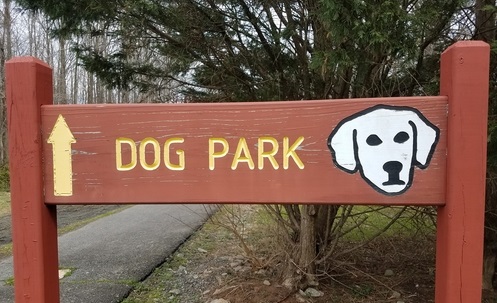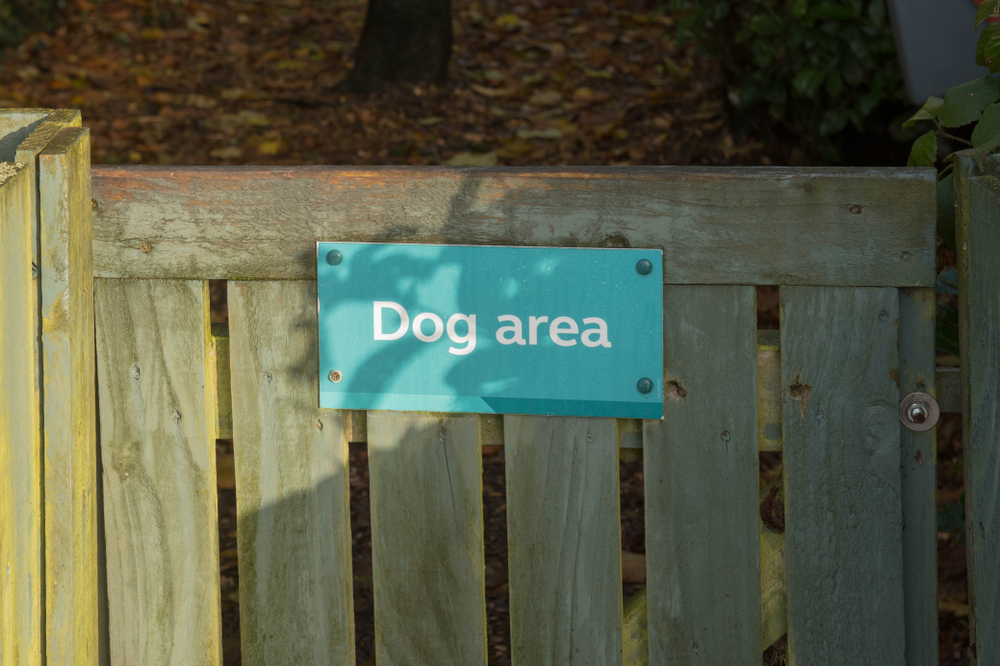It goes without saying that in 2020, dog owners – and their pets – have witnessed a LOT of firsts in the wake of COVID-19. From the health risks incited worldwide to daily game-changers in our routines (like hand sanitizer flying off the shelves and nationwide toilet-paper shortages), people have had to adapt on a global scale in the face of this unprecedented crisis. However, life still goes on – and with it, pet parents have an ongoing responsibility to their fur babies: that is, providing not only food, shelter, and belly rubs, but quality canine-time. Consequently, many pet owners are wondering how they can keep dogs (and themselves) active, fit, and mentally stimulated during the pandemic, all while practicing safety precautions and social distancing. Seems like a tall order? Read on to learn some inventive backyard dog park ideas that are sure to delight pups and their owners alike.
Backyard Dog Park At Home vs. Public Dog Park: Weighing The Pros & Cons
As any veteran pet owner knows, caring for one’s four-legged friend entails physical activity – but it goes far beyond the basic ‘go fetch’ or tossing a Frisbee around on the grass. Dogs are pack animals, meaning they’re instinctively social creatures by design – and therefore, they enjoy going to the park as much (or maybe even more) than their humans do. For those wondering “why build a dog park in my yard?” a DIY backyard park may be the perfect outdoor alternative for a favorite four-legged friend for many reasons.

Besides the convenience a DIY backyard may provide to families, other issues – including the safety, health and well-being of both dogs and dog owners – may also be addressed, making it a viable option worth considering if the space allows for it. On the contrary, there are numerous reasons why bringing the family dog to the local park may not be a good fit. Below, some common scenarios that might make owners reconsider the benefits of a backyard dog park at home:
Behavioral Issues: Dogs are true blue – often considered members of the family, they are loyal companions who bring joy, comfort and affection to their pet parents. However, it’s not uncommon for pups who experienced some form of trauma (e.g., rescue dogs) to display behavioral issues, particularly if they came from an abusive or hostile environment. In other instances, some canines lack discipline – either due to a former owner’s negligence, or simply because their humans haven’t figured out how to train them properly. For a dog who is particularly territorial, aggressive, hyperactive, too pushy, or in a nutshell, “does not play well with others”, a public dog park may not be the best (or safest) environment, either for himself or other dogs and humans. Therefore, a DIY dog park in the yard might be the ideal compromise for folks who are still trying to train their pooch while ensuring he gets his exercise.
Health Risks: Just like their human counterparts, dogs can develop many different types of health problems – some as common as skin conditions, and others as serious as infectious diseases and canine cancer. And just like their pet parents, every dog requires a specific course of care that’s tailored to his physical needs, including his age, breed and overall condition. That’s why it’s important to weight the pros and cons of frequenting a local dog park, as socializing with other dogs can pose some health risks, such as:
- Gastrointestinal Parasites: Intestinal parasites in canines – such as roundworms and hookworms – can make pets very sick, and in some cases, may also be transmitted to humans. And because it can spread so easily at public dog parks (especially if people aren’t picking up after their pets), owners need to be aware of this potential health risk and be diligent about administering heartworm medication as prescribed by a vet.
- Fleas & Ticks: It’s a fact – dogs playing together can potentially pass ticks and fleas. Fortunately, there are a number of effective products on the market to protect pups from these annoying pests. At the end of a romp at the park, be certain to do a tick check to make sure he’s not bringing any of these bugs indoors.
- Heat Stroke: On a hot day, it’s important to keep an eye on active dogs – no matter what their age, canine heat stroke can pose a serious health threat to dogs who may have overdone it at the park. Pups may be especially rambunctious in social settings like a dog park, and sometimes they might not have the sense to stop – even if they’re overheated and dehydrated. Since dogs don’t have many sweat glands (they cool off mostly through panting and evaporation of their foot pads), it’s easy for an exuberant pooch to approach heatstroke levels quickly on a humid afternoon outdoors. Therefore, be sure to monitor his activity closely, carry clean water and a collapsible bowl for all outings, and get him into the shade for a rest if warranted. For signs of canine heat stroke, click here.
- Spread of Infectious Disease: Public dog parks are also a breeding ground for infectious disease – illnesses like canine influenza and kennel cough are easily transmittable and can pose a serious threat to canines of all ages. While there are vaccines for kennel cough, experts recommend speaking with a trusted vet about your dog’s risk for exposure before spending a day at a neighborhood park or other areas where dogs congregate.
Social Distancing: Although there has been a great deal of debate whether or not dogs can spread coronavirus to humans, the CDC reports that “the risk of animals spreading COVID-19 to people is considered to be low”. However, many individuals are maintaining social distancing practices for the safety of themselves and others, so spending time outdoors – particularly at a crowded dog park – may not be as desirable as it once was. Creating a DIY dog park at home may be a better alternative for families searching for safer options for themselves as well as their pets.
Age: Another factor to take into consideration: his age. For example, a geriatric dog who suffers from arthritis or hip dysplasia may make a visit to the neighborhood park challenging, particularly in populated areas where there is a lot of fast-paced canine activity. On the other hand, public dog parks can pose a health risk to puppies, too, particularly if they haven’t been vaccinated yet. In addition, a very young pup may not have developed the social skills needed to interact with bigger or older dogs, and may even become overwhelmed. For these reasons, it’s important for pet owners to get a feel for the park before venturing out with the family dog – seeing if it’s a good fit for his age, activity level and social skills first will ensure if it’s a comfortable environment for everyone involved.
Lifestyle: Finally, there are numerous reasons why a DIY dog park in the backyard may be a better fit for some dog owners. For instance, for pet parents with special needs, making the trip to the local park may not be feasible, especially in inclement weather or in the event where there aren’t adequate accommodations for people with disabilities. In other situations, dog owners with young children may not have the time or ability to wrangle the kids and the pup together and head over to the local park. And in yet another scenario, there may not be a dog park available at all where you live. Whatever the case may be, a DIY dog park in the comfort of one’s own yard can provide convenience, safety, and peace of mind for everyone in the household.
Dog Park DIY: A How-To Guide For Pup Lovers
Whether it’s a huge lawn or a little patio, there’s a DIY dog park design that works for any space – with a little creativity and research, any pet parent can create a fun outdoor space for their fur baby to romp around in. Here’s a few tips to keep in mind when planning the ultimate DIY dog park:

Planning With Intent: First, consider the layout – choose items that will fit within the dimensions of the yard, as well as allow for open space so pets can also run freely. Most importantly, select dog park elements that are appropriate to the dog’s age, size, and breed. Depending on the budget, available space, and personal vision, a DIY dog park can be as simple as a dedicated dog run on the side of the house, or as elaborate as a portion of the yard designed exclusively with furry friends in mind – complete with fountains, dog pools, and an agility course. Here are some popular elements to consider incorporating into a backyard DIY dog park:
- A dog house or some type of sheltered structure
- A paved patio for dog’s food & water bowls
- A built-in water fountain or sprinkler
- A shallow pool (e.g., a child’s plastic pool or a custom in-ground option)
- An obstacle course
- A dedicated potty area (some folks like to use Astro turf for easy clean-up)
- A sandbox/digging area (perfect for dogs who love to dig)
- A dog washing station (e.g., a paved area complete with hose and/or outdoor faucets)
Preparing The Area: Once owners have created a blueprint or rough sketch for the DIY dog park, it’s time to prepare the space, which may include mowing the lawn, weeding, and for more extensive doggie parks, the assistance of professionals, particularly if it entails outdoor plumbing, carpentry, pouring concrete, laying down pavers or other architectural details.
Reduce, Reuse, Recycle: In some instances, pet parents may not have the space, funds or desire to create an elaborate dog park – but that’s ok. Sometimes less is more, and either way, dogs will be happy – as long as they’ve got space to roll around in the grass and be with their people, they’ll be delighted no matter what. Keeping this in mind, consider thinking out of the box – creative owners may consider places like Habitat For Humanity or even Facebook Marketplace as affordable resources for old tires, wooden pallets, buckets, and other common items that can easily translate into an awesome backyard doggie amusement park. For more inspiration, ideas, and what to avoid, check out this article here. And remember, creating an amazing outdoor space for dogs doesn’t have to cost a fortune – ultimately, it’s about spending quality time and deepening the bond between you and your beloved pup.
Sources Cited:
- “How to Create a Backyard Dog Park.” Install It Direct (installitdirect.com), (no published date), https://www.installitdirect.com/learn/how-to-create-a-backyard-dog-park/. Accessed September 19, 2020.
- Ayres, Amy Sinatra. “5 Health Risks Lurking at the Dog Park.” VetStreet (vetstreet.com), May 29, 2015, http://www.vetstreet.com/our-pet-experts/5-health-risks-lurking-at-the-dog-park?page=2. Accessed September 19, 2020.
- Becker, Mikkel. “Dog Parks: Are They for Everyone?” VetStreet (vetstreet.com), June 27, 2014, http://www.vetstreet.com/our-pet-experts/dog-parks-are-they-for-everyone?page=2. Accessed September 19, 2020.




